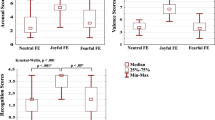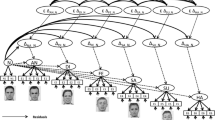Abstract
Differences in oscillatory responses to emotional facial expressions were studied in 40 subjects (19 men and 21 women aged from 18 to 30 years) varying in severity of depressive symptoms. Compared with perception of angry and neutral faces, perception of happy faces was accompanied by lower Δ synchronization in subjects with a low severity of depressive symptoms (Group 2) and higher Δ synchronization in subjects with a high severity of depressive symptoms (Group 1). Because synchronization of Δ oscillations is usually observed in aversive states, it was assumed that happy faces were perceived as negative stimuli by the Group 1 subjects. Perception of angry faces was accompanied by α desynchronization in Group 2 and α synchronization in Group 1. Based on Klimesch’s theory, the effect was assumed to indicate that the Group 1 subjects were initially set up for perception of negative emotional information. The effect of the emotional stimulus category was significant in Group 2 and nonsignificant in Group 1, testifying that the recognition of emotional information is hindered in depression-prone individuals.
Similar content being viewed by others
References
World Health Organization, Sixty-fifth World Health Assembly. http://www.who.int/mediacentre/events/2012/wha65/journal/en/index4.html.
Stuhrmann, A., Suslow, T., and Dannlowski, U., Facial emotion processing in major depression: a systematic review of neuroimaging findings, Biol. Mood Anxiety Disord., 2011, vol. 1, p. 1.
Willner, P., Scheel-Krüger, J., and Belzung, C., The neurobiology of depression and antidepressant action, Neurosci. Biobehav. Rev., 2013, vol. 37, no. 10, pt. 1, p. 2331.
Greicius, M.D., Flores, B.H., Menon, V., et al., Resting-state functional connectivity in major depression: abnormally increased contributions from subgenual cingulate cortex and thalamus, Biol. Psychiatry, 2007, vol. 62, no. 5, p. 429.
Sheline, Y.I., Price, J.L., Yan, Z., and Mintun, M.A., Resting-state functional MRI in depression unmasks increased connectivity between networks via the dorsal nexus, Proc. Natl. Acad. Sci. U.S.A., 2010, vol. 107, no. 24, p. 11020.
Mikhailova, E.S., Vladimirova, T.V., Iznak, A.F., et al., Abnormal recognition of facial expression of emotions in depressed patients with major depression disorder and schizotypal personality disorder, Biol. Psychiatry, 1996, vol. 40, no. 8, p. 697.
Monosova, A.Zh., Mikhailova, E.S., and Belyaev, B.S., Emotional reactivity of patients with depression, Zh. Nevropatol. Psikhiatr. im. S. S. Korsakova, 1990, vol. 90, no. 4, p. 86.
Monosova, A.Zh. and Chayanov, N.V., Zavisimost’ vremeni reaktsii ot intensivnosti i modal’nosti emotsional’nogo vyrazheniya litsa u uchastnikov LPA. Psikhologicheskie posledstviya Chernobyl’skoi katastrofy (Relationships between Reaction Time and Intensity and Modality of Emotional Facial Expression in RCA Participants. Psychological Consequences of Chernobyl Accident), Moscow: Ross. Akad. Nauk, 1992.
Bourke, C., Douglas, K., and Porter, R., Processing of facial emotion expression in major depression: A review, Aust. N. Z. J. Psychiatry, 2010, vol. 44, no. 8, p. 681.
Achenbach, T.M. and Rescorla, L.A., Manual for the ASEBA Adult Forms and Profiles, Burlington, VT: Univ. Vt., Res. Cent. Child., Youth, Fam., 2003.
Ekman, P. and Friesen, W.V., Pictures of Facial Affect, Palo Alto, CA: Consult. Psychol., 1976.
Delorme, A. and Makeig, S., EEGLAB: an open source toolbox for analysis of single-trial EEG dynamics including independent component analysis, J. Neurosci. Methods, 2004, vol. 134, no. 1, p. 9.
Beck, A.T., Steer, R.A., and Brown, G.K., Manual for the Beck Depression Inventory-II, San Antonio, TX: Psychol. Corp., 1996.
Nolen-Hoeksema, S., Gender differences in depression, Curr. Dir. Psychol. Sci., 2001, vol. 10, no. 5, p. 173.
Piccinelli, M. and Wilkinson, G., Gender differences in depression: Critical review, Br. J. Psychiatry, 2000, vol. 177, p. 486.
Cotter, D., Mackay, D., Chana, G., et al., Reduced neuronal size and glial cell density in area 9 of the dorsolateral prefrontal cortex in subjects with major depressive disorder, Cereb. Cortex, 2002, vol. 12, no. 4, p. 386.
Koenigs, M. and Grafman, J., The functional neuroanatomy of depression: distinct roles for ventromedial and dorsolateral prefrontal cortex, Behav. Brain Res., 2009, vol. 201, no. 2, p. 239.
Rogers, M.A., Kasai, K., Koji, M., et al., Executive and prefrontal dysfunction in unipolar depression: a review of neuropsychological and imaging evidence, Neurosci. Res., 2004, vol. 50, no. 1, p. 1.
Knyazev, G.G., EEG delta oscillations as a correlate of basic homeostatic and motivational processes, Neurosci. Biobehav. Rev., 2012, vol. 36, no. 1, p. 677.
Knyazev, G.G., Motivation, emotion, and their inhibitory control mirrored in brain oscillations, Neurosci. Biobehav. Rev., 2007, vol. 31, no. 3, p. 377.
Wacker, J., Dillon, D.G., and Pizzagalli, D.A., The role of the nucleus accumbens and rostral anterior cingulate cortex in anhedonia: integration of resting EEG, fMRI, and volumetric techniques, Neuroimage, 2009, vol. 46, no. 1, p. 327.
Klimesch, W., EEG alpha and theta oscillations reflect cognitive and memory performance: a review and analysis, Brain Res. Rev., 1999, vol. 29, p. 169.
Foxe, J.J. and Snyder, A.C., The role of alpha-band brain oscillations as a sensory suppression mechanism during selective attention, Front. Psychol., 2011, vol. 2, p. 154.
Mazaheri, A., van Schouwenburg, M.R., Dimitrijevic, A., et al., Region-specific modulations in oscillatory alpha activity serve to facilitate processing in the visual and auditory modalities, NeuroImage, 2014, vol. 87, p. 356.
Perfetti, B., Moisello, C., Landsness, E.C., et al., Temporal evolution of oscillatory activity predicts performance in a choice-reaction time reaching task, J. Neurophysiol., 2011, vol. 105, no. 1, p. 18.
Klimesch, W., Evoked alpha and early access to the knowledge system: The P1 inhibition timing hypothesis, Brain Res., 2011, vol. 1408, p. 52.
Klimesch, W., Sauseng, P., and Hanslmayr, S., EEG alpha oscillations: the inhibition-timing hypothesis, Brain Res. Rev., 2007, vol. 53, no. 1, p. 63.
Kohler, C.G., Hoffman, L.J., Eastman, L.B., et al., Facial emotion perception in depression and bipolar disorder: a quantitative review, Psychiatry Res, 2011, vol. 188, no. 3, p. 303.
Langenecker, S.A., Bieliauskas, L.A., Rapport, L.J., et al., Face emotion perception and executive functioning deficits in depression, J. Clin. Exp. Neuropsychol., 2005, vol. 27, no. 3, p. 320.
Author information
Authors and Affiliations
Corresponding author
Additional information
Original Russian Text © G.G. Knyazev, A.V. Bocharov, A.N. Savostyanov, 2016, published in Fiziologiya Cheloveka, 2016, Vol. 42, No. 3, pp. 103–109.
Rights and permissions
About this article
Cite this article
Knyazev, G.G., Bocharov, A.V. & Savostyanov, A.N. Severity of depressive symptoms and oscillatory responses to emotional facial expressions. Hum Physiol 42, 320–325 (2016). https://doi.org/10.1134/S0362119716010114
Received:
Published:
Issue Date:
DOI: https://doi.org/10.1134/S0362119716010114




